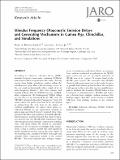Stimulus Frequency Otoacoustic Emission Delays and Generating Mechanisms in Guinea Pigs, Chinchillas, and Simulations
Author(s)
Berezina-Greene, Maria A.; Guinan Jr, John J
Download10162_2015_Article_543.pdf (1.056Mb)
PUBLISHER_POLICY
Publisher Policy
Article is made available in accordance with the publisher's policy and may be subject to US copyright law. Please refer to the publisher's site for terms of use.
Terms of use
Metadata
Show full item recordAbstract
According to coherent reflection theory (CRT), stimulus frequency otoacoustic emissions (SFOAEs) arise from cochlear irregularities coherently reflecting energy from basilar membrane motion within the traveling-wave peak. This reflected energy arrives in the ear canal predominantly with a single delay at each frequency. However, data from humans and animals indicate that (1) SFOAEs can have multiple delay components, (2) low-frequency SFOAE delays are too short to be accounted for by CRT, and (3) “SFOAEs” obtained with a 2nd (“suppressor”) tone ≥2 octaves above the probe tone have been interpreted as arising from the area basal to the region of cochlear amplification. To explore these issues, we collected SFOAEs by the suppression method in guinea pigs and time-frequency analyzed these data, simulated SFOAEs, and published chinchilla SFOAEs. Time-frequency analysis revealed that most frequencies showed only one SFOAE delay component while other frequencies had multiple components including some with short delays. We found no systematic patterns in the occurrence of multiple delay components. Using a cochlear model that had significant basilar membrane motion only in the peak region of the traveling wave, simulated SFOAEs had single and multiple delay components similar to the animal SFOAEs. This result indicates that multiple components (including ones with short delays) can originate from cochlear mechanical irregularities in the SFOAE peak region and are not necessarily indicative of SFOAE sources in regions ≥2 octaves basal of the SFOAE peak region. We conclude that SFOAEs obtained with suppressors close to the probe frequency provide information primarily about the mechanical response in the region that receives amplification, and we attribute the too-short SFOAE delays at low frequencies to distortion-source SFOAEs and coherent reflection from multiple cochlear motions. Our findings suggest that CRT needs revision to include reflections from multiple motions in the cochlear apex.
Date issued
2015-09Department
Institute for Medical Engineering and Science; Harvard University--MIT Division of Health Sciences and TechnologyJournal
Journal of the Association for Research in Otolaryngology
Publisher
Springer US
Citation
Berezina-Greene, Maria A., and John J. Guinan. “Stimulus Frequency Otoacoustic Emission Delays and Generating Mechanisms in Guinea Pigs, Chinchillas, and Simulations.” Journal of the Association for Research in Otolaryngology 16, no. 6 (September 15, 2015): 679–694.
Version: Author's final manuscript
ISSN
1525-3961
1438-7573